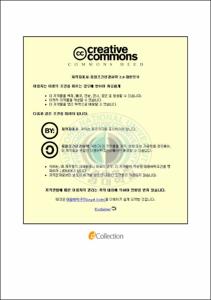잉크젯 프린팅을 이용한 OLED의 정공수송층 제작과 특성에 관한 연구
- Alternative Title
- A Study on the fabrication and characterization of OLED with inkjet-printed hole transport layer
- Abstract
- The use of display and solid state lighting applications based on organic light-emitting diode(OLED) is an emerging technology. Since Tang and Vanslyske demonstrated stable and efficient double-layered OLED in 1987, various efforts have been made to enable their practical application to flat panel display and lighting devices.
Efficient OLED based on small molecular organic materials or polymers have received intensive research interest because of their promising application to full-color flat panel displays. OLED using either small molecules or polymers, have attracted considerable interest due to their easy processability, flexibility, low cost, low operating voltages, wide viewing angles, tunability of the color emission, fast response time, and ease of forming large area. Another of the advantage of OLED is that because OLED were fabricated by wet process such as spin-coating and ink-jet printing from solution, it brings the benefits of cost-effective mass production.
Therefore, this paper studied about manufacture of hole transport layer in OLED by ink-jet printing technology. OLED with ink-jet printed hole transport layer was fabricated as the following structure: ITO glass, hole injection layer, hole transport layer, emitting layer and cathode. The hole transport layer for ink-jet printing was formulated with TPD (N,N'- diphenyl-N,N'-bis(3-methy lphenyl)1-1'biphenyl-4,4'-diamine), PC(polycabonate) and solvent of high boiling point [DCB(1,2-dichlorobenzene, BP 180 ℃), NMP(N-methyl-2-pyrrolido ne, BP 202 ℃)] and THF(tetrahydrofuran, BP 65℃). Ink-jet printing method used with the manufactured solvent ink has proper properties which are viscosity, density, surface tension, is possible to make hole transport layer of OLED. As a result, the luminescence efficiency and light-current-voltage curve of OLED with ink-jet printed hole transport layer were measured. We expect the spin coating method and inkjet method to make hole transport layer will be shortening a process time and cost down.
- Issued Date
- 2008
- Awarded Date
- 2008. 8
- Type
- Dissertation
- Publisher
- 부경대학교 대학원
- Alternative Author(s)
- Lee, Joo Seok
- Affiliation
- 부경대학교 대학원 인쇄공학과
- Department
- 대학원 인쇄공학과
- Table Of Contents
- Ⅰ. 서론 = 1
Ⅱ. 이론 = 4
1. OLED의 기술 = 4
1-1. OLED의 기본구조 = 6
1-2. OLED의 원리 = 8
1-3. OLED의 재료 = 13
2. 잉크젯 프린팅의 기술 = 16
2-1. 잉크젯 기술의 구성 = 18
2-2. 잉크 분사 기술 = 20
2-3. 잉크젯 프린팅 기술의 응용 = 24
Ⅲ. 실험 = 29
1. 잉크젯 프린팅을 위한 정공수송층용 잉크 제조 = 29
2. 잉크젯 프린팅법을 이용한 OLED 제작 = 32
3. 잉크젯용 잉크의 분사성과 액적거동 측정 = 35
4. OLED 특성 측정 = 36
Ⅳ. 결과 및 고찰 = 38
1. 정공수송층용 용제형 잉크의 잉크젯프린팅 특성 = 38
2. 정공수송층 표면상태의 분석 = 42
3. OLED 특성 분석 = 45
3-1. 박막제조법에 따른 발광 스팩트럼 분석 = 46
3-2. 박막제조법에 따른 I-V-L 분석 = 52
Ⅴ. 결론 = 55
References = 56
- Degree
- Master
- Files in This Item:
-
-
Download
 잉크젯 프린팅을 이용한 OLED의 정공수송층 제작과 특성에 관한 연구.pdf
기타 데이터 / 3.32 MB / Adobe PDF
잉크젯 프린팅을 이용한 OLED의 정공수송층 제작과 특성에 관한 연구.pdf
기타 데이터 / 3.32 MB / Adobe PDF
-
Items in Repository are protected by copyright, with all rights reserved, unless otherwise indicated.